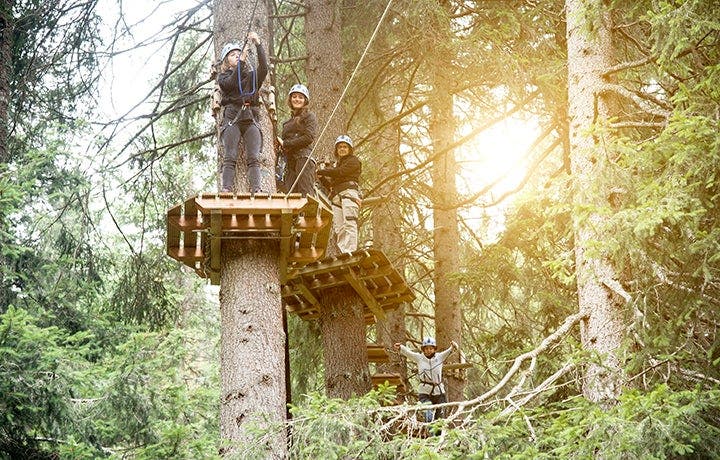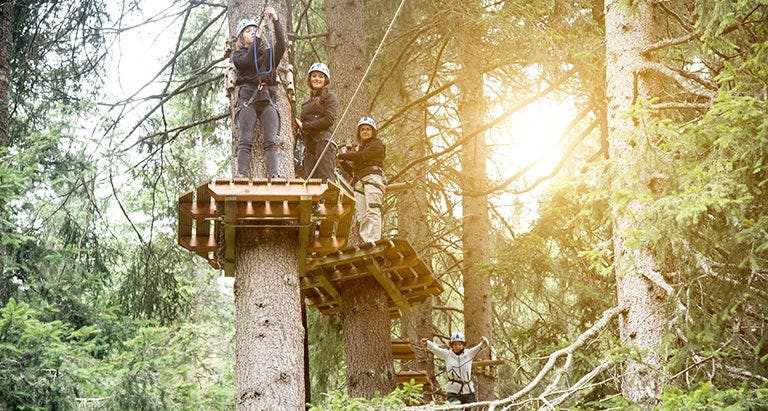How to Stay Safe and Have Fun at an Aerial Adventure Park


Wondering what it’s like to fly through the air with friends and family? Here’s what to expect from this adrenaline-pumping rope-swinging trend.
Be prepared
Aerial adventure parks, also called adventure parks or courses, are popping up everywhere. On these courses you might cross a rope ladder, shuffle across a log, and even leap from one platform to another. At some parks, you might be 10 feet off the ground, while at others it might be 60 feet; some have varying elevations as you progress. Each course is different, but in all of them you’re attached to safety belay cables and move at your own pace from one challenge to the next by walking, crawling, swinging, or climbing.
You can find a course online by searching for “aerial adventure park” or “ropes course park.” Prices vary, but in general, expect to pay $50 per person. Only head to courses that are industry-approved, which require you to wear a helmet, harness system, and closed-toe shoes like sneakers or hiking shoes. If the courses are lax about footwear or safety, consider that a red flag and leave, says Mike Barker, president of the Professional Ropes Course Association. He adds that you should check for approved equipment like the Smart belay or continuous belay, which are the safety-system lanyards (the loop-shaped cord that attaches you to ropes) that are the industry standard. While it’s acceptable to wear shorts, you’ll be more comfortable in loose-fitting pants since you’ll be stepping into the harness system, shimmying it up your legs, and wrapping it around your waist. You’ll then be attached via the lanyard to ropes on the course. If you have long hair, tie it back.
What to expect
Every adventure park has different courses, each of which is rated according to difficulty. They’re marked with one of four colors. Green indicates a beginner track, which is where you should start. “Green is designed so that even if you’re scared, you can make it through,” Barker says. Blue is intermediate, red is more advanced, and black is difficult. Just remember that you’re not racing against a clock, so you can move as slowly or quickly as you want. Some courses, though, use safety systems that don’t allow people to pass, which means you’ll have to go at the same pace as others; if that concerns you, check first.
For moral support and bonding, go with friends or family so you can encourage one another on the course. Do you have kids who want to try it with you? Call the park, as it may have age, height, and weight restrictions. Age requirements vary by course, but some will allow children as young as 5 years old to participate. If you’re on vacation and interested in a ropes course, search for an aerial adventure park nearby that will suit your group.
People who might require medical attention, like pregnant women, shouldn’t attempt a course, nor should anyone who has an issue that restricts normal movements, like back problems or a wrist, shoulder, or foot injury. The surprising part? You’ll need to use your noggin to get through it, as there will be many places where you’ll have to decide how you want to tackle a certain obstacle, and there can be several options. Some of the black courses are designed so most people can’t make it through the first few times.
Understand...
Although it’s easy to psych yourself out, know that everything on these courses is doable and as safe as possible (as long as you’re at a reputable course), Barker says. Instructors or guides are there the entire time to make sure you’re staying safe and even to provide encouragement if you get scared. Some instructors may be up in the ropes with you, while others may be on the ground below.
And don’t worry, they’ll be able to give you an exit route if you need to come down. To help ease your fears, let yourself fall onto your lanyard at the first platform to prove to yourself that you’ll be caught if you fall. Once you realize that you can’t fall, nothing will stop you from completing the course. Worried about the height? As you progress through the course, you’ll have to look down, but if you focus on a specific element (like the rope ladder or log) versus the ground, you won’t notice the height as much, Barker says. You’ll feel so accomplished when you’re done!
Learning curve
It’s common to be a little scared, but trust in your abilities and lean on your guides, and even your friends and family, to help you through.
RELATED: 6 Ways to Feel Comfortable When Exercise Feels Hard
